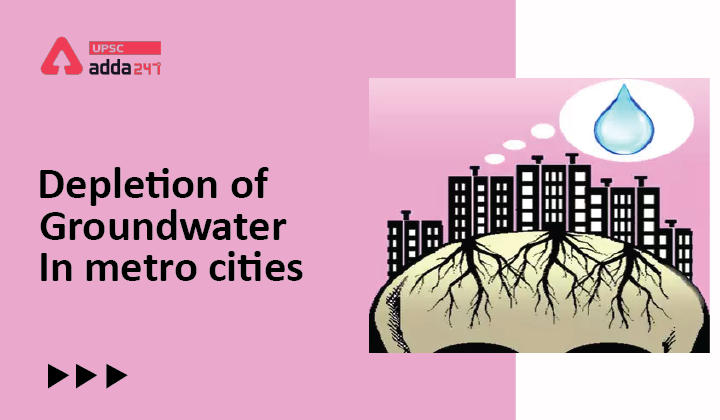Table of Contents
Groundwater Depletion: Relevance
- GS 3: Conservation, environmental pollution and degradation, environmental impact assessment.
Groundwater Depletion: Context
- In order to assess the decline in water level on a long-term basis, the water level data collected by CGWB (Central Ground Water Board) during November 2020 has been compared with the decadal average (2010-2019).
Groundwater Depletion: Key points
- Analysis of water level data indicates about 33% of the wells monitored have registered decline in ground water levels in the range of 0 – 2 m.
- Decline of more than 4.0 m has also been observed in few pockets of Delhi, Chennai, Indore, Coimbatore, Madurai, Vijayawada, Dehradun, Jaipur, Allahabad, Ghaziabad, Kanpur, and Lucknow.
Groundwater depletion: Government steps
- Jal Shakti Abhiyan (JSA) in 2019: a time bound campaign with a mission mode approach intended to improve water availability including ground water conditions in the water stressed blocks of 256 districts in India.
- Jal Shakti Abhiyan: Catch the Rain: Theme “Catch the Rain – Where it Falls When it Falls; to cover all the blocks of all districts (rural as well as urban areas) across the country during 22nd March 2021 to 30th November 2021.
- Atal Bhujal Yojana: Sustainable management of ground water resources with community participation. It is a Rs.6,000.00 crore central sector scheme, being implemented in 81 water stressed districts and 8774 Gram Panchayats of seven States viz. Gujarat, Haryana, Karnataka, Madhya Pradesh, Maharashtra, Rajasthan and Uttar Pradesh.
- National Aquifer Mapping and Management program (NAQUIM): NAQUIM envisages mapping of aquifers (water bearing formations), their characterization and development of Aquifer Management Plans to facilitate sustainable management of Ground Water Resources in the country.
- Master Plan for Artificial Recharge to Groundwater – 2020: Central Ground Water Board (CGWB) in consultation with States/UTs has prepared this plan, which is basically a macro level plan indicating various structures for the different terrain conditions of the country including estimated cost.
- Guidelines for states: Ministry of Housing & Urban Affairs (MoHUA) has formulated guidelines for the States to adopt measures suitable to local conditions, such as Unified Building Bye Laws (UBBL) of Delhi, 2016, Model Building Bye Laws (MBBL), 2016 and Urban and Regional Development Plan Formulation and Implementation (URDPFI) Guidelines, 2014, wherein adequate focus has been given on requirement of rainwater harvesting and water conservation measures.
- States initiatives: ‘Mukhyamantri Jal Swavlamban Abhiyan’ in Rajasthan, ‘Jalyukt Shibar’ in Maharashtra, ‘Sujalam Sufalam Abhiyan’ in Gujarat, ‘Mission Kakatiya’ in Telangana, Neeru Chettu’ in Andhra Pradesh, Jal Jeevan Hariyali in Bihar, ‘Jal Hi Jeevan’ in Haryana among others.
- Jal Jeevan Mission: Ministry of Jal Shakti in partnership with States, is implementing Jal Jeevan Mission (JJM) to provide potable tap water supply of prescribed quality to every rural household in the country by 2024.
- AMRUT: The Mission focuses on development of basic urban infrastructure in 500 AMRUT cities, such as water supply, sewerage & septage management, storm water drainage, green spaces & parks, and non-motorized urban transport.
Also Read:
What Should be a New National Water Policy?
Arsenic Found in Wheat, Potato in Rural Bihar
City Water Balance Plan
Geospatial Technologies In Water Sector
Rainwater harvesting: Countering Water Scarcity
Water Declaration



 TSPSC Group 1 Question Paper 2024, Downl...
TSPSC Group 1 Question Paper 2024, Downl...
 TSPSC Group 1 Answer key 2024 Out, Downl...
TSPSC Group 1 Answer key 2024 Out, Downl...
 UPSC Prelims 2024 Question Paper, Downlo...
UPSC Prelims 2024 Question Paper, Downlo...
